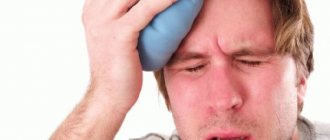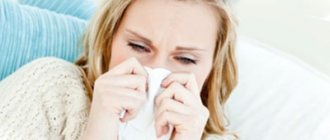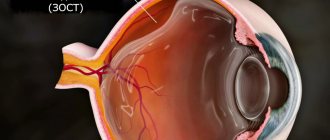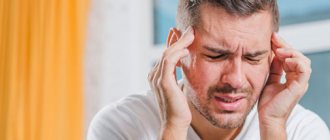Today we will talk about Her Majesty Migraine - how to live in relative harmony with it, how to relieve the excruciating headaches caused by this disease, and how you can reduce the frequency of attacks.
Dmitry Gonchar February 22, 20215 min read 917
Hemicrania or migraine is primarily a hereditary neurological disease associated with pathologically high sensitivity of cerebral vessels. Unfavorable external and/or internal factors periodically cause dilation and inflammation of these vessels, which results in attacks of severe headaches and other “signature” symptoms of migraine – sound and photophobia, nausea, etc.
The term “migraine” itself comes from a New Latin word that passed into the French language - hemicrania, which means “half of the head.” The symptoms of migraine were described in ancient Greek medical works, and the ancient Greeks considered evil forces to be the culprits of the disease (and it was proposed to drive out the evil spirit from the head by drilling a hole in the skull, but these are details :)).
Migraine as such does not pose a threat to the health and life of the person suffering from it. During migraine, the blood vessels of the brain do not undergo any lasting changes - they dilate and become inflamed only during an attack, and then return to normal. By the way, people suffering from migraines, in most cases, are characterized by a clear mind, good memory, high cognitive abilities - all this persists for many years. True, painful migraine attacks nullify all these positive aspects.
How to distinguish migraine from other types of headaches?
The signs of a migraine usually cannot be confused with anything, since its main and most common symptom is a strong, no, VERY STRONG headache, of a pulsating or bursting nature, most often localized in one half of the head (although sometimes the pain takes over the entire head). It can be concentrated both in the frontal or temporal regions, and in other areas. Movement, light, sounds, any physical activity and other factors aggravate migraine headaches.
A migraine attack or migraine attack often occurs in four stages:
1. Prodrome - a feeling of anxiety, a premonition of an impending attack. Occurs in just over 50% of migraine patients. Prodrome can manifest itself as irritability, depression, fatigue or, conversely, unhealthy activity, increased appetite, or simply a feeling of “knowing” that an attack is coming soon. The prodrome occurs in different ways: for some, a couple of hours before the attack, and for others, several days before.
2. Aura , which is manifested by various visual, tactile, gustatory, olfactory and other disturbances. We will tell you more about the aura below.
3. The headache itself is usually very severe. Its duration can vary from half an hour to 2-3 days, depending on the type and severity of migraine.
4. The postdromal period is a kind of “recovery” after an attack, usually accompanied by a feeling of weakness and apathy.
Severe migraine attacks may be accompanied by vomiting, dizziness, darkness in the eyes and other related symptoms. Many patients note that vomiting provides some relief from both the headache and the general serious condition during an attack.
What is migraine with aura?
Migraine can be with or without aura. Migraine aura is a whole symptomatic complex that appears either before or simultaneously with a headache attack. Aura with migraine occurs:
1. Visual , with flashes before the eyes, “fog”, glare, visual distortions and even loss of individual visual fields.
2. Auditory , accompanied by ringing or noise in the ears, and in severe cases, auditory hallucinations.
3. Sensory , in which taste and smell change.
4. Aphasic , when speech is impaired.
5. Motor , which is accompanied by difficulties in moving the arms and legs, up to the inability to walk.
6. Vestibular , with dizziness, loss of balance and even falls.
Several types of migraine aura can be combined at the same time, but they are all associated with vascular spasm that occurs in the brain at the beginning of the attack.
There is also a migraine without an aura - it manifests itself only as episodic headaches, without the symptoms described above.
Other types of migraines
There are also other types of migraine, which are much less common than “classical” migraine with or without aura. For example:
- cervical , with very severe headaches - it is usually associated with disturbances in blood flow in the vertebral artery;
- ocular migraine is necessarily accompanied by the symptoms described above for visual migraine aura (flashes, flickering, glare, loss of visual fields). Headache attacks with this form of migraine are short (maximum half an hour), and it is associated with pathology of blood flow in the occipital region of the cerebral cortex;
- retinal migraine – in which headaches are accompanied by short-term blindness, which is associated with spasms of retinal vessels;
- paroxysmal chronic - it is characterized by short attacks that repeat several times during the day;
- hemiplegic , with a feeling of severe weakness throughout the body and impaired sensitivity (paresthesia) on the half of the body opposite the side of the headaches. Develops against the background of circulatory disorders in the brain, attacks are short-lived (maximum hour);
- abdominal – usually occurs in children. It causes stomach pain, nausea, vomiting, and diarrhea;
- aphasic , in which speech disturbances begin at the very peak of pain.
By the way, there is another, extremely rare type of migraine, which has been called “ decapitated migraine ”. This type of disease is expressed only by a migraine aura, and the head does not hurt.
Causes of migraine
As already mentioned, migraine is a hereditary disease. Moreover, according to statistics, women suffer from it three times more often than men. Some modern researchers tend to see this as a connection with the hormones of the menstrual cycle, in the last phase of which the levels of certain hormones (progesterone, estrogen) drop in the female body - they say, this can provoke attacks. However, there is also a theory that women simply visit doctors more often for headaches, and therefore are more often diagnosed with migraine.
According to WHO, migraine usually begins simultaneously with puberty, causing the most severe suffering in 35-45 year old people. In any case, the disease recedes with age - due to both hormonal changes and a decrease in the elasticity of blood vessels.
In principle, migraine began to be studied in detail relatively recently - only in 1960. Before that, it was considered the lot of anxious people, a kind of mental disorder. Methysergide entered the pharmaceutical market, the disease was transferred to the category of physiological and began to be studied in more detail.
At the moment, it is known that migraine is directly related to mutations of certain genes - they provoke hyperactivity of brain neurons and excessive excitation in its areas responsible for processing sensory information (light, sound). Seizures can be caused by external stimuli - triggers , for example:
- lack of sleep (or excess);
- stress (and sometimes relaxation after stress);
- hunger, thirst;
- certain foods: chocolate, sugar, cheese, meat, salty foods, sometimes coffee (although in some cases coffee, on the contrary, helps relieve a migraine attack);
- alcoholic drinks;
- strong smells, sounds, light;
- excessive physical activity;
- climate and/or weather changes, etc.
It has also been proven that the development of chronic migraine can be associated with excess weight, depression, anxiety, certain diseases (for example, hypothyroidism), as well as uncontrolled and too frequent use of headache medications .
How big is the problem?
Migraine, a neurological disease characterized primarily by severe attacks of headache, has been known for more than 3000 years [3]. However, despite the well-studied symptoms and manifestations, the causes of migraine have not yet been fully established. It was previously believed that migraine is caused by changes in cerebral circulation, but many researchers now suggest that this is not the main cause [4].
Current understanding of the pathogenesis of migraine involves the involvement of certain neural pathways and neuropeptides, particularly the trigeminal nerve and CGRP, a calcitonin gene-related peptide. Research has shown that excited nerve cells can activate the trigeminal nerve, leading to the release of CGRP and other neuropeptides. CGRP greatly dilates blood vessels, causing local swelling, and this attracts cells involved in the process of inflammation. With inflammation of the vessels of the skull and dura mater, proinflammatory molecules stimulate pain endings in the meninges, which leads to migraine (Fig. 1) [5–8].
This excitation of nerve cells, which triggers migraine, is associated with heredity and physiology, but today its causes are far from precisely determined [3]. It is only known that this process can be provoked by a variety of factors: from banal stress, fatigue and insufficient sleep to current hormonal levels, depressive states and medication use [9].
Figure 1. Pathogenesis of migraine
What happens during a migraine attack?
At the same time, migraine manifests itself not only as a headache: the symptoms of this serious illness are much more diverse, and often more painful. Debilitating migraine attacks can be painful and unbearable and sometimes last from several hours to several days, accompanied by nausea, vomiting and increased sensitivity to light, sound and smell [3], [10]. Such attacks deprive millions of people around the world of the ability to think, live and work normally. It is believed that every seventh inhabitant of the planet suffers from migraine today, and in the ranking of causes limiting the ability to work, this disease took second place in the world (according to 2021 data) [11], [12].
It is not surprising that migraine was included by the World Health Organization in the list of diseases that most disrupt the social adaptation of patients [3].
How to treat migraine?
No way. It is impossible to completely cure any disease caused by genetic defects. But there is good news! Nowadays medicine, unlike ancient Greek, no longer offers drilling holes in the skull to expel the evil spirits of migraines, but now there are medications that can:
- alleviate the condition during an attack;
- slightly reduce the intensity and frequency of attacks.
Since it is impossible to completely get rid of migraines, you need to strive to bring them into “perfect balance.” That means:
- no more than 2 attacks per month;
- The duration of each attack is no longer than 2 hours.
What can be done for this?
1. Identify your triggers (factors that provoke an attack) and, if possible, avoid them.
2. Talk to your doctor about medications that can help make attacks less painful, and start taking them. What kind of drugs are these?
Relaxation for migraines
Relaxation is a set of exercises that helps relieve tension during migraines. These are muscle relaxation techniques, breathing exercises, meditation. Relaxation training is carried out under the supervision of a psychotherapist individually or in group programs.
One of the preventive treatments for migraine is the administration of botulinum toxin. This treatment is effective in people who, during an attack, experience squeezing headaches that radiate to the eye. The effect develops a month after the injections. After a few months, the procedure must be repeated.
Medicines for migraines and other headaches
For headaches (with migraine and not associated with migraine), the doctor may prescribe any drugs from the group of NSAIDs - non-steroidal anti-inflammatory drugs. All medications in this group relieve headaches by stopping inflammation of the vascular wall. Moreover, some NSAIDs contain not only an analgesic component (painkiller), but also additional substances - for example, sedatives or antispasmodics (relieving spasms).
Based on the presence or absence of these additional substances, these drugs are divided into:
- one-component
- multicomponent (combined).
Single-component include drugs containing only the NSAID itself, for example:
- acetylsalicylic acid - Aspirin, Upsarin, etc. To relieve an attack, a single dose of 500 mg or more is usually prescribed.
IMPORTANT! Effervescent tablets are absorbed faster, so if you have a migraine, it is better to take them, especially if the attack is accompanied by nausea.
IMPORTANT! Drugs for the prevention of strokes and heart attacks containing acetylsalicylic acid (Trombo ACC, Cardiomagnyl, Aspirin Cardio, etc.) are not suitable for our purposes, since the dosage of the active substance in them is very low.
- acetaminophen (paracetamol) - Paracetamol, Efferalgan, Panadol, etc. It must be said that in order to combat migraines, paracetamol itself is not very effective, so it is better to pay attention to combination drugs containing it;
- ibuprofen - Ibuprofen, Nurofen, Brufen, etc. - as in the case of acetylsalicylic acid, the doctor may prescribe 500 mg or more of ibuprofen per dose to relieve migraine headaches;
- metamizole sodium - Baralgin, Analgin. IMPORTANT! It is undesirable to constantly take metamizole sodium preparations, since this substance can change the composition of the blood and also negatively affects the liver and kidneys;
- naproxen – Nalgesin, Naproxen. A popular remedy among people suffering from migraines, naproxen preparations are available both single-component and combined, and the average dosage for attacks is usually 500–750 mg;
- diclofenac – Diclofenac, Voltaren, etc.
- ketorolac (Ketanov) and lornoxicam (Xefocam) are very powerful analgesics. They, like some of the above drugs (for example, Baralgin), can be prescribed by a doctor for migraines not only in tablet form, but also in the form of injections.
In addition, if during a migraine attack the patient experiences severe nausea, an anesthetic drug from the NSAID group can also be prescribed in the form of suppositories used rectally - for example, Cefekon D with paracetamol, Indomethacin with indomethacin, Voltaren with diclofenac, etc.).
* * *
Among the multicomponent (combined) painkillers that are often used to relieve migraine attacks and headaches of other origins are:
- Askofen, Citramon - drugs with approximately the same content of acetylsalicylic acid, paracetamol and caffeine. IMPORTANT! To relieve migraine attacks, the doctor prescribes these medications only to those patients who do not have a tendency to vascular spasms and increased blood pressure (this is due to the caffeine content in both drugs).
- Pentalgin - however, it can be used for migraines only in consultation with a doctor. The fact is that different types of this medicine have different compositions and if, for example, Pentalgin ICN can alleviate an attack, then “ordinary” Pentalgin will not bring any benefit for migraines. By the way, the drugs Sedal-M and Sedalgin Neo have a composition similar to Pentalgin ICN.
- Tempalgin, which contains metamizole sodium (which we already discussed above and recommended not to take it regularly due to dangerous side effects).
- Spazmalgon - like Tempalgin, it also contains metamizole sodium, so the precautions should be identical.
- Andipal - in addition to metamizole sodium, contains phenobarbital - a substance that quickly becomes addictive.
Triptans for migraines
In addition to the listed “broad-spectrum” painkillers, special analgesics specifically against migraine are also available on the pharmaceutical market.
It is known that many people suffering from migraines, even with the help of a qualified specialist, cannot choose for themselves a truly effective painkiller from the NSAID group. But in the late 80s of the last century, the first special medicine against migraine, Sumatriptan, was developed in Germany. Under its influence, the vessels dilated during a migraine attack narrow, and therefore it is sumatriptan that still acts as the “gold standard” in the treatment of migraine. It belongs to the triptan , which was later replenished with several more similar substances, each of which can significantly make life easier for people suffering from migraines.
Preparations containing sumatriptan - Imigran, Sumamigren, Amigren, Antimigren, etc. Preparations containing other triptans - Rizamigren (active ingredient - rizatriptan), Zolmigren (zolmitriptan), Relpax (eletriptan), etc. There is a whole section on the Liki24.com website, which presents migraine medications from licensed pharmacies in Ukraine.
IMPORTANT! None of these drugs should be taken on your own initiative, without the consent of your doctor . The fact is that they all have a number of serious contraindications for use (primarily arterial hypertension, ischemia, varicose veins, thrombophlebitis, etc.), as well as many possible negative side effects.
Before you start using triptans, you must undergo a medical examination with an electrocardiogram and some tests.
When taking triptans should also be discussed with your doctor. These drugs cannot be taken during an aura, in order to “anticipate” the pain - in this case, the effect will be the opposite: the aura will last, and the headache during the attack will be more intense.
Ergotamine derivatives for migraine
Another class of anti-migraine drugs are ergotamine derivatives (Nomigren, Caffetamine, etc.). These are “older” medications; in many countries, doctors do not prescribe them for continuous use, but use them only for emergency cases - for example, if the patient has been suffering from an attack for several days, and ordinary analgesics do not help (status migraine).
IMPORTANT! You cannot combine the use of triptans and ergotamine derivatives - they must be “spaced” apart by at least 24 hours.
IMPORTANT! Ergotamine derivatives have many contraindications for use, including pregnancy and lactation, ischemia, arterial hypertension, glaucoma, vascular diseases, etc.
How to understand that the chosen analgesic is effective?
A properly selected migraine medicine must meet the following conditions:
- completely relieve the headache no later than 4 hours from the moment of administration;
- relieve nausea and photophobia in the first 2 hours after administration (during the same period, the headache should stop “pulsating” and gradually subside);
- effectively stop every or almost every attack;
- the attack should not be repeated the next day;
- During an attack, a single dose of the drug is sufficient (there is no need to take it additionally or any additional medicine).
If the analgesic does not meet these requirements, you should consult your doctor about choosing another drug that is more effective for you.
Medicines for nausea during a migraine attack
Nausea and/or vomiting during a migraine attack is not only unpleasant, but also harmful, since it does not allow the analgesics taken to be absorbed normally. Therefore, if nausea sets in, it is advisable to take an antiemetic drug - Ondansetron, Cerucal or others. They can even be taken simultaneously with an anesthetic, unless otherwise indicated in the instructions for these drugs (see the section “Interaction with other drugs”).
IMPORTANT! At the beginning of the attack, even before the onset of nausea and headaches, the function of the stomach is already impaired - contents are retained in it. To prevent the same fate from befalling the taken analgesic, which will remain in the stomach in an undigested form, corroding the mucous membrane and leading to even greater nausea, you can take any peristalsis stimulant (Motilium, Motorix, Domrid, etc.) as prescribed by a doctor.
Migraine treatment today
Unfortunately, today there is no medicine that can get rid of migraines once and for all. The drugs used can mainly reduce the intensity and number of attacks or reduce symptoms and relieve pain. In this regard, therapy with such drugs is divided into two groups:
- Abortive (acute) therapy - to relieve or reduce symptoms of migraine that has already appeared.
- Preventative treatment – to reduce the intensity, duration or frequency of attacks.
In this article we talk about drug treatment and prevention, but leave behind the scenes a variety of non-pharmacological treatments for migraine: from relaxation techniques to cognitive behavioral psychotherapy and transcranial electrical stimulation. Meanwhile, these methods in some cases can be an effective alternative to medications in case of resistance or contraindications to drug therapy, and sometimes effectively complement it in the combined treatment of migraines [13].
Abortion therapy
In the treatment of mild to moderate migraines, various analgesics and NSAIDs (non-steroidal anti-inflammatory drugs) are prescribed, including the well-known paracetamol, acetylsalicylic acid and ibuprofen, sometimes in combination with caffeine, codeine or psychotropic substances in combination medications [14], [15]. ]. A significant drawback is the possible reverse effect of uncontrolled use of analgesics: worsening headaches, which in such conditions can become daily [8], [15].
When it comes to dealing with more severe and prolonged attacks of migraine pain, the “heavy artillery” comes into play, namely ergot alkaloids and triptans. Triptans were the first drugs created specifically for the treatment of migraine; They began to be developed back in 1972. Even then it was known that the ergot alkaloid ergotamine can reduce migraine attacks, which was associated with its vasoconstrictor effect [16]. This drug remained the only specific treatment for migraine until, in 1991, rational research finally led to the emergence of sumatriptan, the first drug of a new class that acts in a similar way to ergotamine, but is more effective and safe (Fig. 2) [16].
Unlike its famous derivative, LSD, ergotamine itself does not have hallucinogenic properties.
Figure 2. Triptans, medications used to relieve migraines, are selective serotonin receptor agonists. They bind to and activate specific subtypes of these receptors (5HT1B, 5HT1D and 5HT1F). This leads to inhibition of the release of neurotransmitters from the presynaptic membrane of the trigeminal nerve endings (shown in yellow), located in the vessels of the head. At the same time, the release of the already mentioned CGRP, a key neurotransmitter that causes migraines, is also inhibited. This “neural” mechanism of action is believed to block the main pathological link in the development of migraine. It is also known that taking triptans selectively constricts the vessels of the dura mater, reduces the permeability of the vascular wall and reduces edema. Either way, these medications are effective—they reduce inflammation and pain, as well as the intensity of accompanying migraine symptoms [17]. The ergot alkaloids ergotamine and dihydroergotamine act in a similar way, although they are less selective - they can bind to dopamine and adrenergic receptors, which is why their effectiveness and safety are lower.
[18]
However, despite their good efficacy and safety profile, triptans may theoretically be dangerous for patients with coronary artery disease due to their vasoconstrictor effects, which limits their widespread use as therapy for migraine [16].
Preventive therapy
Drug prevention is indicated when migraines are regular (more than 2-3 times a month), and it must be said that today such therapy is not entirely safe and effective: it is associated with significant side effects and the development of rapid tolerance to treatment (tachyphylaxis) [14]. In this case, several classes of drugs are used, originally developed for other indications, and so far with a largely unclear mechanism of action for migraine. These medications include: tricyclic antidepressants, antiepileptic drugs, beta blockers, calcium channel blockers, ACE inhibitors and some others [14], [19].
By the way, you can read about many of the listed drugs, their direct indications, history of appearance and mechanism of action in the first article of our series “Three generations of drugs” [1].
Preventing migraine attacks
To reduce the frequency and intensity of migraine attacks, doctors recommend:
- avoid stressful situations if possible;
- maintain a healthy sleep schedule, sleep in a dark and quiet room;
- give up foods that can provoke an attack (or at least reduce their quantity) - chocolate, baked goods, red wine, large amounts of coffee;
- follow a diet and drinking regime - try not to go hungry and drink enough clean, still water;
- add ginger and cayenne pepper to food in moderation;
- use medicinal plants - lavender (lotions) and mint (lotions, decoctions for oral administration).
Many people suffering from migraines are helped to reduce the frequency and intensity of attacks by compresses from ice packs, cold hand baths, massages (acupressure or collar area and head) - but all these measures must be selected purely individually.
In addition, it is recommended to take magnesium and vitamins B6 and B2 - they can be taken both as mono supplements and as part of mineral-multivitamin complexes. Of course, you should take any dietary supplements for migraines only after consulting your doctor.
Liki24.com targeted medicine delivery service wishes you good health!









